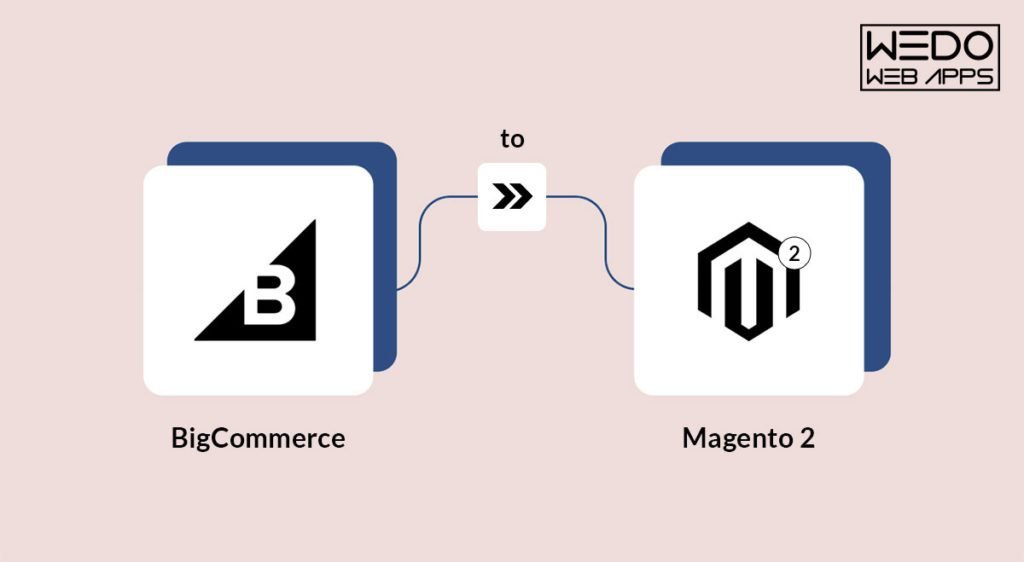10 Mar, 2023 | Magento development
BigCommerce To Magento 2 Migration: How To Do It?

What Is BigCommerce?
 BigCommerce is an e-commerce platform that enables business owners to create and manage their online stores remotely with just an Internet connection and a web browser. Users do not need to invest in additional web hosting or software, as BigCommerce runs on its own servers. BigCommerce offers a range of customizable templates including ecommerce website builder to help you build the perfect look for your online store. This platform is a great way to market physical and digital products and tools, making it easier to promote your business. Moreover, it is primarily geared toward those lacking website design knowledge. Still, it is also useful to tech-savvy customers and developers who need to customize their online store's HTML and CSS. The platform is well-known for its easy-to-use interface. So, it is a great choice for those who want to establish an online ecommerce business but lack the technical know- how to host a website. With the platform, you can effortlessly build a bigcommerce website without any prior experience.
BigCommerce is an e-commerce platform that enables business owners to create and manage their online stores remotely with just an Internet connection and a web browser. Users do not need to invest in additional web hosting or software, as BigCommerce runs on its own servers. BigCommerce offers a range of customizable templates including ecommerce website builder to help you build the perfect look for your online store. This platform is a great way to market physical and digital products and tools, making it easier to promote your business. Moreover, it is primarily geared toward those lacking website design knowledge. Still, it is also useful to tech-savvy customers and developers who need to customize their online store's HTML and CSS. The platform is well-known for its easy-to-use interface. So, it is a great choice for those who want to establish an online ecommerce business but lack the technical know- how to host a website. With the platform, you can effortlessly build a bigcommerce website without any prior experience. Ensure a smooth transition from BigCommerce to Magento 2 with our comprehensive ecommerce development solutions.
BigCommerce Pros
There are certain pros of BigCommerce as per the performance and scalability:-
- Scalability: BigCommerce is an ideal platform for ecommerce businesses of any size, offering the flexibility to scale up as your store's needs increase easily. With BigCommerce, you can start small and be confident that your business will have the resources to expand as it grows.
- Robust SEO Elements: BigCommerce is highly regarded for its outstanding SEO features, making it one of our favorite ecommerce platforms.
- Incredible Features: BigCommerce has more built-in features than any other ecommerce website builder, eliminating the need to purchase additional apps, thus saving you money.
- Zero Transaction Charges: BigCommerce does not levy any transaction fees with its plans, making it an economical option for businesses with tight profit margins and a high volume of transactions.
- Variety Of Products: This system makes creating product options and variations quick and straightforward. There are no restrictions on the number of choices you can offer, allowing for a wide range of product configurations. This flexibility makes it much easier to provide customers with exactly what they're looking for.
BigCommerce Cons
With plenty of pros, there are certain cons to keep in mind as well for making a well-informed decision:- Limited subscription elements: If you want to offer subscription services or accept regular payments, you must purchase a third-party application.
- Less multilingual alternatives: It is impossible to accomplish this using bigcommerce's native functionality; the only way to do it is with the help of a third-party application.
- Zero email marketing devices: BigCommerce does not offer any email marketing services, so you will have to purchase an outside application to get this function.
Analyzing Your Current BigCommerce Store
Before proceeding with the Bigcommerce data migration process, you should study your currently available store on BigCommerce properly.-
Identifying elements to keep from your BigCommerce store
-
Choosing Your Magento Version: Community Edition Vs Enterprise Edition
Why Should You Move from BigCommerce to Magento 2?
In terms of usability, BigCommerce promises high-quality functions and user-friendliness. In contrast, Magento is more widely used and handles more web stores across different websites. Not to mention, it covers a wide range of categories as well as e-commerce sites and is compatible with various software types. Overall, there are many ways Magento is a better choice and businesses should consider it for bigcommerce to magento migration to reap the benefits.-
Enjoy more payment gateway options.
-
Advanced-Data Security
 Indeed, Magento 2 comes up with update announcements for patchwork frequently. However, while quicker updates are available in Magento 2, users must operate these with more focus.
Indeed, Magento 2 comes up with update announcements for patchwork frequently. However, while quicker updates are available in Magento 2, users must operate these with more focus. -
Compliance with PCI DSS
-
Superior Interface and Theme Customizations
-
Better Apps and Extensions
How To Perform the BigCommerce to Magento 2 Migration Process?
There are different methods available for BigCommerce to Magento 2 data Migration process. Choose as per your preference, and take professional help with the process for the best results.Method 1: Using Data File Transfer
The following are the main stages of BigCommerce to Magento Migration using data files.Step 1: Export the website item of your BigCommerce
In the first stage of data migration process , developers export the items to the BigCommerce website, alongside other things like catalog, shipping price , customer IDs, customers, and XML/CSV-format-based properties. Go to the BigCommerce extensions under the named category.Step 2: Import Data Files to the Magento 2
Next, you have to opt for the "Improved Import & Export" extension for importing the BigCommerce-based extension data.- Firstly, contact the Magento 2 admin and choose the System option.
- Under this section, click on the Improved Import/Export option.
- Then, choose the Import Jobs option to prepare the new import job.

Step 3: Jump into the Setting Process
Following these steps, you should focus on the General Settings steps. For that, you have to change the import behavior, import setting, basic settings, etc.- Under Import Settings, choose the entity you will move to Magento 2 from BigCommerce. Update parameters like Advanced Pricing, Products, Categories, etc.
- Tap on Import Behavior and choose a prepare behavior. Also, you should select a suitable validation approach and insert separators for the migration.
- In the Import Source section, select the import file type and source. Make more setup changes and check them.
- Finally, compare the properties noticeable in Magento 2 with those in BigCommerce. Operate a matching grid within a mapping preset or extension.
Method 2: Through API
With the advanced Import & Export module on the Magento 2 version, professionals can directly connect with BigCommerce and transfer files through it. For this, they must utilize the available APIs best suitable for SOAP/REST link-based file transfers.Step 1: Create Your New Import Job
You must click on the System option and choose the Improved Import/Export module. Then, under the Magento 2 admin, choose Import Jobs and prepare a new one.Step 2: Setting Process
It would be best if you continued the setting up process in the General Settings, Import Behavior, Import Settings, and Import Source next. While you are making configuration changes in the same categories, the steps you will handle are slightly different in all these categories.- Under General Settings, you should add your job title and make extra condition setups.
- In Import Settings, you should activate the API transfers by changing the Use API option to YES. Then, select the entity for BigCommerce to Magento 2 migration.
- Under Import Behavior, you have to choose your preferred import behavior and validating strategy here. Also, type the separators.
- Then, for the Import Source, select the import file format, source option between SOAP or REST, and other parameters.
Step 3: Set Up Other Processes to Validate the Data File
Validate the data file to finalize it. Then, you have to select and activate Manual Grid, or the available presets for BigCommerce attribute mapping into Magento 2 attributes. This will confirm the whole data migration process to complete.Conclusion
Overall, Magento 2 is a high-caliber ecommerce platform with easy ecommerce website builder to which you can turn your ecommerce website for the best service improvement for your digital store. It comes with more theme customization benefits, payment gateway options, extensions, and more benefits. So, follow ahead with the BigCommerce to Magento 2 migration steps in your preferred sequence using API or data files. These steps can become complex to handle. For the best results, you should take the help of high-grade migration service like WeDoWebApps.com. Our talented Magento professionals have experience with different complex migration steps and can handle that as you request. You can also request a free demo to understand if it's right service you. Start free demo migration today.Frequently Asked Questions
In the e-commerce sphere, BigCommerce and Magento 2 are top platforms for high-grade e-store hosting and management. So, it is natural to wonder which one to use for the long term. In my opinion, both versions are equally useful. BigCommerce, in particular, has many benefits for users, like more plugins, extensions, etc. However, this platform costs more money, while Magento 2 offers paid and free extensions for website building.
BigCommerce is user-friendly and simple to operate, but the less restrictive Magento 2 is more popular, which leads to BigCommerce to Magento 2 migration. This transfer is suitable because Magento 2 migration provides benefits like:
- More payment options
- Better theme customization
- Diverse extensions to use
- Improved data security
- PCI-DSS compliance
Import tools are available for default use to migrate the online stores and websites from BigCommerce to Magento 2’s ecosystem. You can also conduct migration before you proceed with real migration. However, many of these are challenging to manage as the import/export tools have more restrictions and support fewer objects. You need to add another module for this with Magento 2 (now Adobe commerce) compatibility. While using the Improved Import & Export extension, users can handle quick data import and migration for BigCommerce, in two ways:
- Through data transfers
- Via API connections

